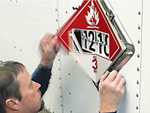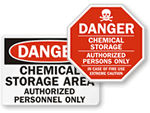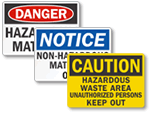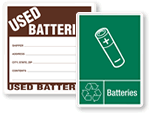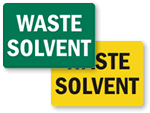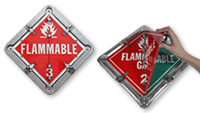A.
Based on the hazard classes, hazmat placards are of the following types:
1. Hazard Class 1 Placard — Explosives
These are for explosives such as TNT, ammunition, fireworks, and airbag inflators. Orange in color, these placards have one of six sub-categories:
1: Mass Explosion Hazard
2: Mass Projection Hazard
3: Fire/Minor Blast/Minor Projection Hazard
4: Minor Explosion Hazard
5: Blasting Agent
6: Very Insensitive Materials
2. Hazard Class 2 Placard — Gases
These are for fire extinguishers, aerosols, propane tanks, and gas cartridges. Placards colors signify the following:
- Green: Non-Flammable Gas
- Red: Flammable Gas
- White: Toxic Gas
- Yellow: Oxygen Gas
- White with Black Skull Inset: Inhalation Hazard
3. Hazard Class 3 Placard — Flammable and combustible liquids
These are for flammable liquids like gasoline, paint, acetone, and kerosene. Red in color, these placards identify liquid substances having a flashpoint less than 60 °Celcius (140 °F), or any material in a liquid phase with a flashpoint at or above 37.8 °Celcius (100 °F).
4. Hazard Class 4 Placard — Flammable materials
These are for flammable solids such as matches, powdered metals, and activated carbon. Different color schemes mean the following:
- Red and White Stripes: Flammable Solids
- Upper Half White, Lower Half Red: Spontaneously Combustible Solids
- Blue: Water-Reactive Solids
5. Hazard Class 5 Placard — Oxidizer and organic peroxide
These are for oxidizing substances and organic peroxides such as ammonium nitrate fertilizer and chemical oxygen generators. They have two different categories:
- Yellow: Oxidizer
- Red Top, Yellow Bottom: Organic Peroxide
6. Hazard Class 6 Placard — Poisons
These are for toxic and/or infectious substances like regulated medical waste, tear gas, and strong poisons such as cyanides and neonicotinoids. They have two design schemes:
- White: Toxic
- White with Black Skull Inset: Inhalation Hazard
7. Hazard Class 7 Placard — Radioactive
These are for radioactive substances such as medical isotopes and radioactive ore. They have a yellow top that features the international symbol for radiation and a white bottom.
8. Hazard Class 8 Placard — Corrosive
These are for corrosive chemicals such as strong acids, lye, and certain dyes and paints. They have a white top with an illustration of a chemical burning a human hand and a black bottom.
9. Hazard Class 9 Placard — Miscellaneous
These are for other hazardous substances such as dry ice and lithium-ion batteries. These placards have a black and white striped top half and a white bottom.











